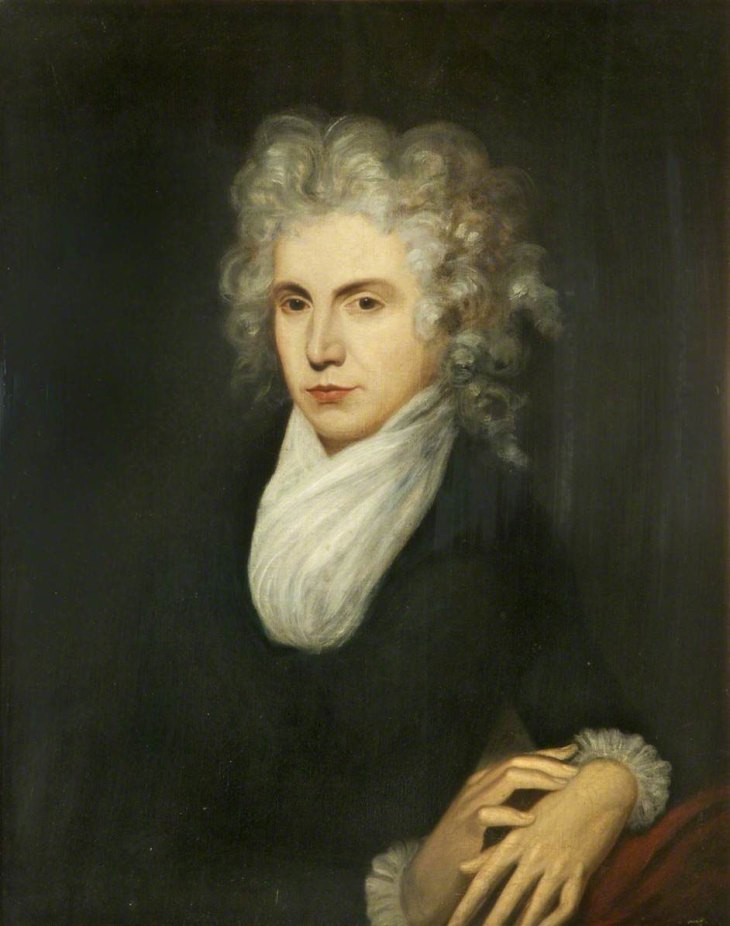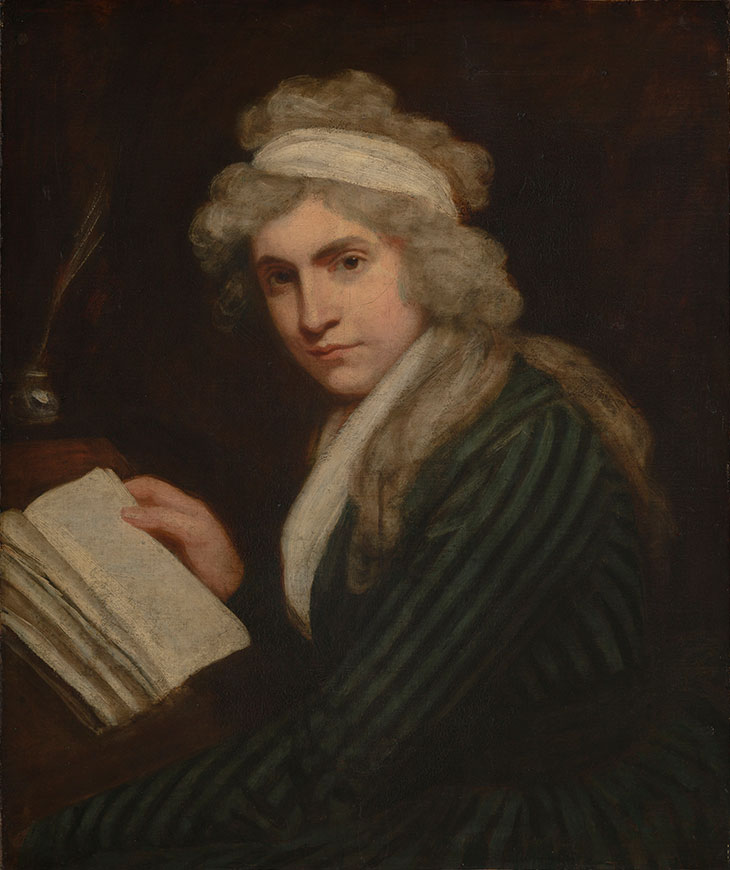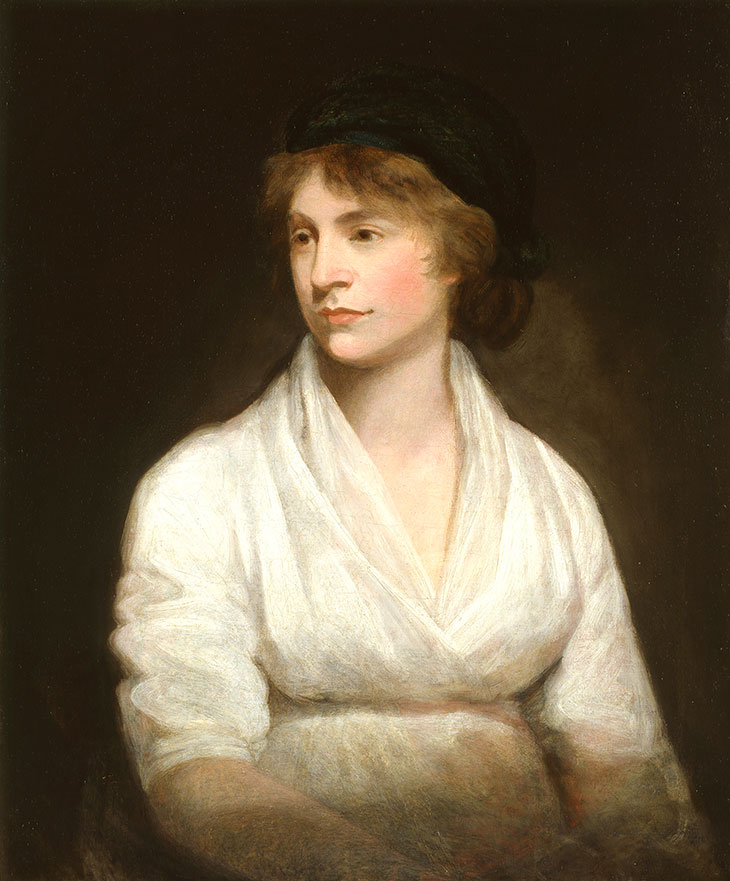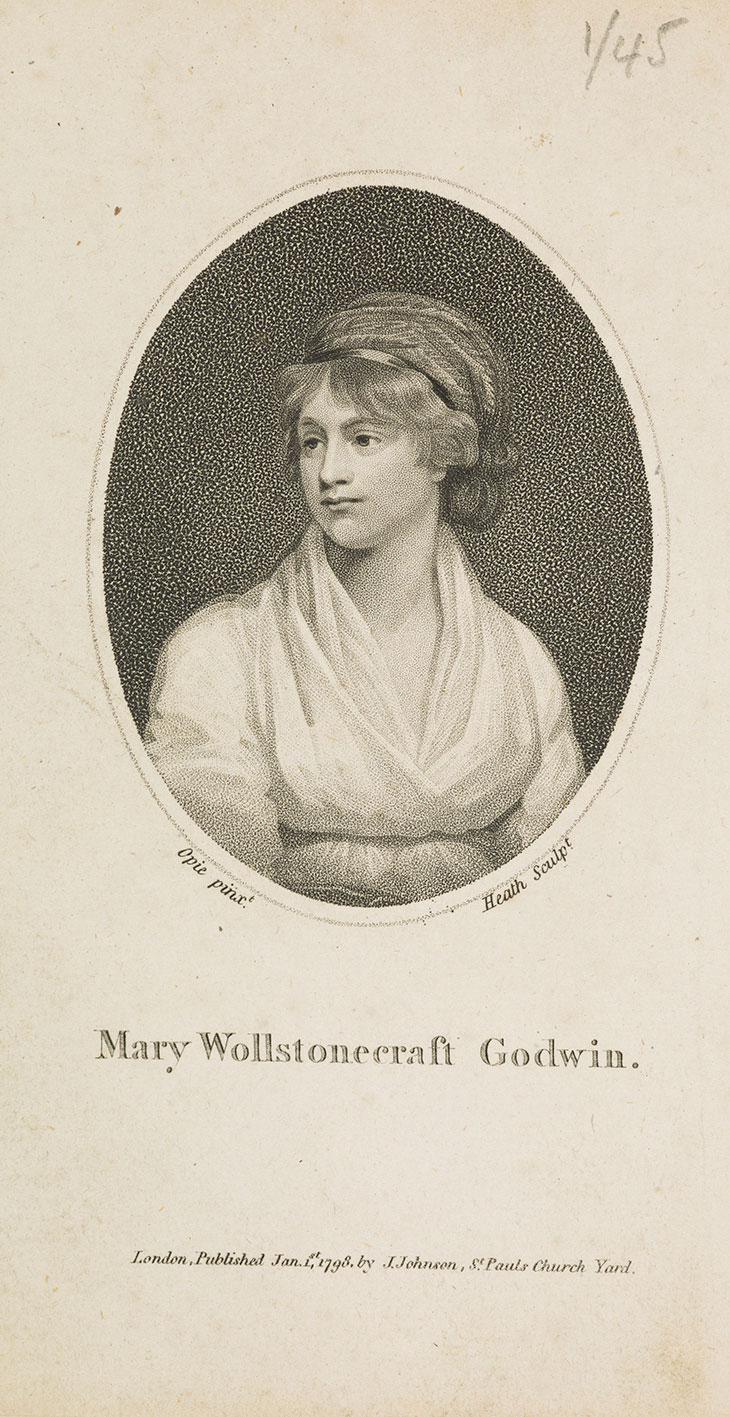As the debate around Maggi Hambling’s monument to Mary Wollstonecraft’s legacy reaches its second week, there has been little scrutiny so far of other artworks that commemorate the writer, philosopher and women’s rights advocate, who was famously described as ‘that hyena in petticoats’ by Horace Walpole. Best known today for A Vindication of the Rights of Woman (1792), Wollstonecraft was a prolific writer, whose publications included a conduct book, a novel, a travel diary, several children’s morality tales, a treatise calling for the abolition of slavery and a history of the French revolution. She lived an unconventional life of courage and conviction. Yet her image has long been fixed in our collective imagination: as the striking, thoughtful woman captured in two portraits by her friend John Opie.
This is rather a limited view. Two other portraits from earlier in Wollstonecraft’s life present different glimpses of the writer. In 1786, shortly after her best friend Fanny Blood died in childbirth, Wollstonecraft spent a brief and unhappy period working as a governess in Ireland, before her employment by the radical London publisher Joseph Johnson as a writer for his new magazine, the Analytical Review, launched in 1788. The earliest surviving portrait of Wollstonecraft probably dates from her time in Ireland, where she was painted by John Keenan, a pupil of the artist Robert Home, brother-in-law to her friend Betty Delane. It was around this time that Wollstonecraft published Thoughts on the Education of Daughters (1787). This first book, a manual of conduct, was positively if quietly received. In Keenan’s portrait, now in a private collection, a serious young woman clad in full mourning cannot disguise her impatience as she is interrupted from her reading. Her book functions as a shield of sorts, a line of defence between sitter and viewer.

Mary Wollstonecraft (1791–92), attributed to John Williamson. Walker Art Gallery, Liverpool
No such prop is needed in the Walker Art Gallery’s portrait of Wollstonecraft, attributed to John Williamson. In 1790, Wollstonecraft had become an overnight sensation, thanks to the publication that year of A Vindication of the Rights of Men, a repudiation of Edmund Burke’s conservative Reflections on the Revolution in France. This portrait depicts an assertive, intellectual force. Her elegant hands are conspicuously free of rings and adornments, and her powdered hair, simple black dress and plain white collar – perhaps a version of half mourning – downplay her sex. It was probably commissioned by her friend the abolitionist Sir William Roscoe, before she moved to Paris in 1792 to escape her unreciprocated feelings for the artist Henry Fuseli. Roscoe owned a small collection of paintings commemorating his friends and fellow radicals, including a portrait of Fuseli as well as Wollstonecraft (‘I like your Revolutionary Song,’ Wollstonecraft wrote to Roscoe, in response to his verses in praise of the French Revolution).

Mary Wollstonecraft (c. 1790–91), John Opie. Photo: © Tate
In 1792, when Wollstonecraft published A Vindication of the Rights of Woman, her vision of equality between the sexes sealed her reputation as an extraordinary if eccentric thinker. The first of Opie’s well-known portraits dates from around this time. It is strikingly lit. With her powdered hair bound in a white scarf and spilling across her shoulders, Wollstonecraft stares out from a dark interior, interrupted in her thoughts, half her face in shadow. The slanting desk and prominent quill make it clear that Wollstonecraft is a woman at work, not reading for pleasure. The portrait was later engraved by William Ridley for the Monthly Mirror in 1796. That year Wollstonecraft published her Letters from Sweden, which detailed the solo journey she took at the end of her unhappy affair with the American businessman Gilbert Imlay, the father of her first child.
Opie’s second portrait was almost certainly painted to celebrate Wollstonecraft’s marriage to William Godwin in March 1797, when she was already pregnant with her second daughter – Mary, future author of Frankenstein. In this portrait, Wollstonecraft sits without the attributes of her craft. Her determined, appraising gaze is turned away from the viewer. The unconventionally severe blacks and greys of earlier portraits have been replaced by a delicate white muslin Empire dress, a sartorial choice that was the height of fashion, if a little plain. Her unpowdered hair is covered by a green turban in a simple yet conventional style, though this headgear may have reminded contemporary viewers of the turbans worn by the sibyls of Greek mythology. The painting remained over the mantelpiece in Godwin’s house after Wollstonecraft’s death following childbirth in September 1797, and even after his remarriage. ‘To take another wife with the picture of Mary Wollstonecraft in his house! Agh!’ wrote the poet Robert Southey to Samuel Taylor Coleridge in 1804.

Mary Wollstonecraft (c. 1797), John Opie. National Portrait Gallery, London
In 1798, James Heath’s engraving after this portrait was published as the frontispiece to Wollstonecraft’s posthumous Memoirs, Godwin’s tribute to his late wife. Heath softens Wollstonecraft’s angular, appraising face, giving her the larger doe eyes and plump cheeks of youthful innocence. This butter-wouldn’t-melt image soon became the unlikely face of scandal, due to the Memoirs’ shocking revelations of Wollstonecraft’s extramarital relationships and her struggles with mental health.
In the 19th century, Opie’s portraits continued to circulate as illustrations to Wollstonecraft’s works, which retained a significant transatlantic readership despite the notoriety of the Memoirs. In the 1870s, her grandson Sir Percy Florence Shelley granted the scholar Charles Kegan Paul access to the family archives, inspiring several publications on Godwin, Wollstonecraft and their circle. Both of Opie’s portraits reappeared soon after. In 1884, the National Gallery purchased the earlier portrait, prompting some debate between Kegan Paul and the institution’s director Frederic Burton as to its date and authenticity (it was later transferred to the Tate). In 1899 Sir Percy’s widow Lady Shelley bequeathed Opie’s second portrait to the National Portrait Gallery.

Mary Wollstonecraft Godwin (1798), engraving by James Heath after a portrait by John Opie. National Galleries Scotland
Since then the latter portrait remains the most widely reproduced image of Wollstonecraft. The street artist Stewy used it as inspiration for his mural at the Unitarian Chapel in Newington Green – where in 1784 Wollstonecraft and two of her sisters had opened a small girl’s school – and his related prints. Martin Jennings’ rival design for the Newington memorial statue presented a somewhat frumpier take on her cowl neckline and downwards glance. Unkempt curls, empire-line dresses and trailing headscarves define Wollstonecraft’s appearance in graphic novels and comics, where John Opie meets Wonder Woman. Opie’s portrait has become a kind of shorthand for Wollstonecraft’s visual identity – a veritable Marilyn of a feminist icon. Given the current uproar over what qualifies as an appropriate monument to Wollstonecraft, it seems ironic that our most enduring image of her should be a portrait painted to commemorate her marriage, not her writing. Powerful as Opie’s painting is, this seems a good moment to re-examine our loyalty to canonical representations, and the authority these images have in shaping their subject’s legacy.
Imogen Tedbury is the Simon Sainsbury Curatorial Fellow at the National Gallery. She is the author of Modern Portraits for Modern Women: Principals and Pioneers from the Royal Holloway and Bedford New College Art Collection (Royal Holloway).

‘That hyena in petticoats’: how artists have portrayed Mary Wollstonecraft
Mary Wollstonecraft (detail; c. 1797), John Opie. National Portrait Gallery, London
Share
As the debate around Maggi Hambling’s monument to Mary Wollstonecraft’s legacy reaches its second week, there has been little scrutiny so far of other artworks that commemorate the writer, philosopher and women’s rights advocate, who was famously described as ‘that hyena in petticoats’ by Horace Walpole. Best known today for A Vindication of the Rights of Woman (1792), Wollstonecraft was a prolific writer, whose publications included a conduct book, a novel, a travel diary, several children’s morality tales, a treatise calling for the abolition of slavery and a history of the French revolution. She lived an unconventional life of courage and conviction. Yet her image has long been fixed in our collective imagination: as the striking, thoughtful woman captured in two portraits by her friend John Opie.
This is rather a limited view. Two other portraits from earlier in Wollstonecraft’s life present different glimpses of the writer. In 1786, shortly after her best friend Fanny Blood died in childbirth, Wollstonecraft spent a brief and unhappy period working as a governess in Ireland, before her employment by the radical London publisher Joseph Johnson as a writer for his new magazine, the Analytical Review, launched in 1788. The earliest surviving portrait of Wollstonecraft probably dates from her time in Ireland, where she was painted by John Keenan, a pupil of the artist Robert Home, brother-in-law to her friend Betty Delane. It was around this time that Wollstonecraft published Thoughts on the Education of Daughters (1787). This first book, a manual of conduct, was positively if quietly received. In Keenan’s portrait, now in a private collection, a serious young woman clad in full mourning cannot disguise her impatience as she is interrupted from her reading. Her book functions as a shield of sorts, a line of defence between sitter and viewer.
Mary Wollstonecraft (1791–92), attributed to John Williamson. Walker Art Gallery, Liverpool
No such prop is needed in the Walker Art Gallery’s portrait of Wollstonecraft, attributed to John Williamson. In 1790, Wollstonecraft had become an overnight sensation, thanks to the publication that year of A Vindication of the Rights of Men, a repudiation of Edmund Burke’s conservative Reflections on the Revolution in France. This portrait depicts an assertive, intellectual force. Her elegant hands are conspicuously free of rings and adornments, and her powdered hair, simple black dress and plain white collar – perhaps a version of half mourning – downplay her sex. It was probably commissioned by her friend the abolitionist Sir William Roscoe, before she moved to Paris in 1792 to escape her unreciprocated feelings for the artist Henry Fuseli. Roscoe owned a small collection of paintings commemorating his friends and fellow radicals, including a portrait of Fuseli as well as Wollstonecraft (‘I like your Revolutionary Song,’ Wollstonecraft wrote to Roscoe, in response to his verses in praise of the French Revolution).
Mary Wollstonecraft (c. 1790–91), John Opie. Photo: © Tate
In 1792, when Wollstonecraft published A Vindication of the Rights of Woman, her vision of equality between the sexes sealed her reputation as an extraordinary if eccentric thinker. The first of Opie’s well-known portraits dates from around this time. It is strikingly lit. With her powdered hair bound in a white scarf and spilling across her shoulders, Wollstonecraft stares out from a dark interior, interrupted in her thoughts, half her face in shadow. The slanting desk and prominent quill make it clear that Wollstonecraft is a woman at work, not reading for pleasure. The portrait was later engraved by William Ridley for the Monthly Mirror in 1796. That year Wollstonecraft published her Letters from Sweden, which detailed the solo journey she took at the end of her unhappy affair with the American businessman Gilbert Imlay, the father of her first child.
Opie’s second portrait was almost certainly painted to celebrate Wollstonecraft’s marriage to William Godwin in March 1797, when she was already pregnant with her second daughter – Mary, future author of Frankenstein. In this portrait, Wollstonecraft sits without the attributes of her craft. Her determined, appraising gaze is turned away from the viewer. The unconventionally severe blacks and greys of earlier portraits have been replaced by a delicate white muslin Empire dress, a sartorial choice that was the height of fashion, if a little plain. Her unpowdered hair is covered by a green turban in a simple yet conventional style, though this headgear may have reminded contemporary viewers of the turbans worn by the sibyls of Greek mythology. The painting remained over the mantelpiece in Godwin’s house after Wollstonecraft’s death following childbirth in September 1797, and even after his remarriage. ‘To take another wife with the picture of Mary Wollstonecraft in his house! Agh!’ wrote the poet Robert Southey to Samuel Taylor Coleridge in 1804.
Mary Wollstonecraft (c. 1797), John Opie. National Portrait Gallery, London
In 1798, James Heath’s engraving after this portrait was published as the frontispiece to Wollstonecraft’s posthumous Memoirs, Godwin’s tribute to his late wife. Heath softens Wollstonecraft’s angular, appraising face, giving her the larger doe eyes and plump cheeks of youthful innocence. This butter-wouldn’t-melt image soon became the unlikely face of scandal, due to the Memoirs’ shocking revelations of Wollstonecraft’s extramarital relationships and her struggles with mental health.
In the 19th century, Opie’s portraits continued to circulate as illustrations to Wollstonecraft’s works, which retained a significant transatlantic readership despite the notoriety of the Memoirs. In the 1870s, her grandson Sir Percy Florence Shelley granted the scholar Charles Kegan Paul access to the family archives, inspiring several publications on Godwin, Wollstonecraft and their circle. Both of Opie’s portraits reappeared soon after. In 1884, the National Gallery purchased the earlier portrait, prompting some debate between Kegan Paul and the institution’s director Frederic Burton as to its date and authenticity (it was later transferred to the Tate). In 1899 Sir Percy’s widow Lady Shelley bequeathed Opie’s second portrait to the National Portrait Gallery.
Mary Wollstonecraft Godwin (1798), engraving by James Heath after a portrait by John Opie. National Galleries Scotland
Since then the latter portrait remains the most widely reproduced image of Wollstonecraft. The street artist Stewy used it as inspiration for his mural at the Unitarian Chapel in Newington Green – where in 1784 Wollstonecraft and two of her sisters had opened a small girl’s school – and his related prints. Martin Jennings’ rival design for the Newington memorial statue presented a somewhat frumpier take on her cowl neckline and downwards glance. Unkempt curls, empire-line dresses and trailing headscarves define Wollstonecraft’s appearance in graphic novels and comics, where John Opie meets Wonder Woman. Opie’s portrait has become a kind of shorthand for Wollstonecraft’s visual identity – a veritable Marilyn of a feminist icon. Given the current uproar over what qualifies as an appropriate monument to Wollstonecraft, it seems ironic that our most enduring image of her should be a portrait painted to commemorate her marriage, not her writing. Powerful as Opie’s painting is, this seems a good moment to re-examine our loyalty to canonical representations, and the authority these images have in shaping their subject’s legacy.
Imogen Tedbury is the Simon Sainsbury Curatorial Fellow at the National Gallery. She is the author of Modern Portraits for Modern Women: Principals and Pioneers from the Royal Holloway and Bedford New College Art Collection (Royal Holloway).
Unlimited access from just $16 every 3 months
Subscribe to get unlimited and exclusive access to the top art stories, interviews and exhibition reviews.
Share
Recommended for you
‘No more pushing around of Mrs Pankhurst’
The site of Emmeline Pankhurst’s statue in Westminster was chosen by her fellow suffragists – there is no reason for it to change
A history of the US women’s suffrage movement in five objects
This August marks the centennial of the ratification of the 19th Amendment, which granted women the right to vote in America
How Victorian artists saw Florence Nightingale
The bicentenary of the founder of modern nursing has a particularly topical resonance, but how did her contemporaries regard the Lady with the Lamp?